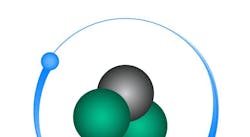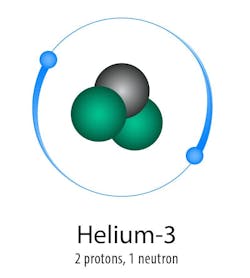Researchers Devise a Long-Sought Workaround to Helium-3 Shortage
Engineers rely on neutrons to peer inside advanced materials and devices such as fuel cells to better understand and improve them. But a critical shortage of a rare form of helium (helium-3) used for detecting neutrons, which are difficult to spot directly, threatens to slow advances in this critical type of materials research.
To solve the problem, a team at the National Institute of Technology (NIST) discovered a way to replace expensive and scarce helium-3 gas with previously studied and more abundant crystals. Their new approach achieved greater than 90% efficiency in detecting neutrons, making it a viable alternative.
Helium-3 is a rare isotope of helium with one neutron instead of two. Its nucleus breaks apart easily when struck by a neutron, and the fragments can then be detected when they strike a high-voltage wire. For decades, this has made helium-3 an ideal tool for materials scientists to probe inside dense objects. National security officials also use it in ports and at border crossings to spot stray neutrons emanating from illicit radioactive materials such as the ingredients for nuclear bombs.
Ironically, it is the manufacture of nuclear weapons that provided a steady supply of helium-3 in the first place. The isotope is hard to come by; it only makes up about 0.0001 % of the Earth’s natural helium reserves. It is also one of the decay products of tritium, a key element in hydrogen bombs, and scientists have been able to siphon helium-3 from idle warheads for decades. Now that the U.S.s has reduced production of such explosives, materials scientists need a new way to detect the neutrons after being beamed at cutting-edge materials, which scatter the neutrons in ways that reveal the materials’ internal structures.
Scientists have long known of another detection method that uses the more available chemicals zinc sulfide and lithium-6 fluoride, but its use has been limited for exploring dense materials because of its inefficiency. Scientists need the most efficient detection method they can find because even the most intense neutron sources only generate low-intensity trickles of neutrons.
“Helium-3 is the gold standard for neutron detection work because its efficiency is around 95, says Kevin Pritchard, a NIST engineer working on the project. “The lithium-6 fluoride approach is down around 30%, which isn’t nearly good enough for our purposes. We spent several years trying to improve it.”
The alternative approach calls for crystals of zinc sulfide and lithium-6 fluoride be made at just the right sizes and mixed together in an even distribution and spacing in a single medium.
When a neutron hits lithium-6, it breaks into two smaller particles that strike some nearby zinc sulfide, making it glow. The team repeated past experiments indicating that with crystals of the correct size, the efficiency should rise to nearly 100%, but even with properly sized crystals it wasn’t lighting up brightly enough.
Electron microscope images revealed that crystalline particles were clumping together in ways that prevented lithium-6 fragments from reaching the zinc sulfide. The team worked with industry to tweak the concentration of the binding agent holding the crystal mix together, and this change finally gave them an efficiency above 90% and rivaling helium-3’s.
Aside from freeing the neutron detection community from depending on nuclear bombs for their helim-3, this method has other potential advantages. Most importantly, detectors can be made much thinner, as a gas requires more volume than a solid and needs to be kept at high pressure as well.
“This might let us fit more detectors in, so we can collect more neutrons and get a more accurate picture,” Pritchard explains. “So, it would be an advantage even if we had plenty of helium-3.”
It might also help with fossil fuel exploration, as mining companies have used neutron detectors for years. Smaller, cheaper detectors could more effectively provide answers about rock structures deep underground.


